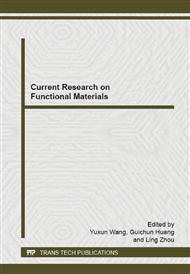[1]
Y. F. Liu, J. S. Yu, In situ synthesis of highly luminescent glutathione-capped CdTe/ZnS quantum dots with biocompatibility, J. Colloid Interface Sci. 351 (2010) 1-9.
DOI: 10.1016/j.jcis.2010.07.047
Google Scholar
[2]
A. Nag, M.V. Kovalenko, J. -S. Lee, W. Liu, B. Spokoyny, D.V. Talapin, Metal-free Inorganic Ligands for Colloidal Nanocrystals: S2–, HS–, Se2–, HSe–, Te2–, HTe–, TeS32–, OH–, and NH2–as Surface Ligands, J. Am. Chem. Soc. 133 (2011) 10612-10620.
DOI: 10.1021/ja2029415
Google Scholar
[3]
A. M. Qin, X. Zhou, Y. Qiu, Y. Fang, C. Su, S. Yang, Periodically twinned nanotowers and nanodendrites of mercury selenide synthesized via a solution–liquid–solid route, Adv. Mater. 20 (2008) 768-773.
DOI: 10.1002/adma.200701127
Google Scholar
[4]
A.M. Qin, Y. P. Fang, C.Y. Su, Hydrothermal synthesis of HgTe rod-shaped nanocrystals, Mater. Lett. 61 (2007) 126-129.
DOI: 10.1016/j.matlet.2006.04.020
Google Scholar
[5]
N. Gaponik, D.V. Talapin, A.L. Rogach, K. Hoppe, E.V. Shevchenko, A. Kornowski, A. Eychmüller, H. Weller, Thiol-capping of CdTe nanocrystals: an alternative to organometallic synthetic routes, J. Phys. Chem. B 106 (2002) 7177-7185.
DOI: 10.1021/jp025541k
Google Scholar
[6]
D. M. Zhao, L. G. Sun, Y. J. Wang, Y. H. Du, C. Wang, Preparation and Application of CdTe Nanocrystals, Prog. Chem. 24 (2012) 1277-1293.
Google Scholar
[7]
D.V. Talapin, S. Haubold, A.L. Rogach, A. Kornowski, M. Haase, H. Weller, A novel organometallic synthesis of highly luminescent CdTe nanocrystals, J. Phys. Chem. B 105 (2001) 2260-2263.
DOI: 10.1021/jp003177o
Google Scholar
[8]
S. Mahesh, A. Gopal, R. Thirumalai, A. Ajayaghosh, Light-induced Ostwald ripening of organic nanodots to rods, J. Am. Chem. Soc. 134 (2012) 7227-7230.
DOI: 10.1021/ja301002g
Google Scholar
[9]
Z. Q. Liu, S.P. Liu, S. G. Yan, P. F. Yin, Y. Q. He, Interaction between GSH-CdTe QDs and L-Aspartic Acid and Its Analytical Application, Acta. Chim. Sinica 69 (2011) 2969-2974.
Google Scholar
[10]
T. Ding, Y. Q. Xu, H. Gu, Y. R. Liang, X.M. Fang, L. Q. Zhang., Properties of poly (ethylene glycol)‐based bioelastomers, J. Appl. Polym. Sci. 118 (2010) 2442-2447.
Google Scholar
[11]
H. Wen, C. Dong, H. Dong, A. Shen, W. Xia, X. Cai, Y. Song, X. Li, Y. Li, D. Shi, Engineered Redox‐Responsive PEG Detachment Mechanism in PEGylated Nano‐Graphene Oxide for Intracellular Drug Delivery, Small 8 (2012) 760-769.
DOI: 10.1002/smll.201101613
Google Scholar
[12]
Q. Y. Liu, L. Jiang, R. Shi, L.Q. Zhang, Synthesis, preparation, in vitro degradation, and application of novel degradable bioelastomers—A review, Prog. Polym. Sci. 37 (2012) 715-765.
DOI: 10.1016/j.progpolymsci.2011.11.001
Google Scholar


